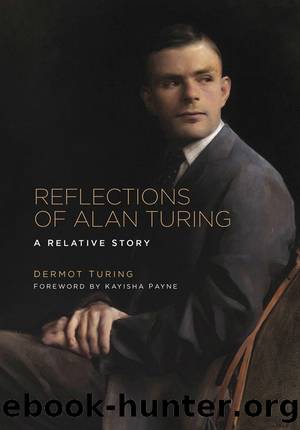Reflections of Alan Turing by Dermot Turing

Author:Dermot Turing
Language: eng
Format: epub
Publisher: The History Press
Cybermen (which may be robots, but are probably actors) from the 2014 Doctor Who series. (Adrian Rogers / BBC / Everett Collection / Alamy)
The Robot Fallacy has evolved subtly since 1948. I am often privileged to be asked to attend and sometimes to speak at gatherings where artificial intelligence is on the agenda, since the begetter of the whole business, Alan Turing, is usually present in spirit (and on the agenda himself) at these events. Frequently, someone in the audience will ask about the dangers of super-intelligent machinery â a subject which deserves proper study â but almost invariably the experts giving the lectures will say something along the lines of, âI think you watch too many science fiction movies; robots arenât about to take over the world.â With that cheap laugh we can move on and avoid a difficult discussion about controls and limitations in a rapidly growing area of research. If it happens to you â donât stand for it, complain that you didnât mention robots, and demand a proper answer to your question.
Back in 1948, Alan Turingâs paper, called âIntelligent Machineryâ, was spiked. The NPL is now rather proud of it, but it was not until 1968, fourteen years after Alanâs death, that it was first published.8 Alan Turing wanted to be heard on the subject of machines and intelligence, but nobody wanted to listen. Alan was bored and frustrated, but his old teacher and mentor came to the rescue. The sabbatical year was spent at Cambridge, where Alan bumped into M.H.A. Newman, who had first put the idea of machine processes for algorithms into his head back in 1935, and now Newman suggested that Alan might come to work in Newmanâs new âRoyal Society Computing Machine Laboratoryâ in Manchester. Alan jumped at the idea, and jumped ship. The rest of his life was spent in Manchester.
Newmanâs Manchester computer was âactually working 8/7/48â â Alan put this little dig at NPLâs interminable delay into his âIntelligent Machineryâ paper â and ran its first routine on 21 June 1948. In fact, the machine was only a âbabyâ â a proof-of-cncept device, rather like the Pilot model of the ACE which Alan Turing disparaged as a distraction from the full-size ACE which might never get built. But another, bigger Manchester machine was coming into being, and when that came into service later that year there was another round of fun in the newspapers.
The story is quite well known. Computers were for sums, even old sums: so the Manchester computer had been put through its paces on an old, unsolved problem dating from the 1600s. This was to find which numbers of the form 2nâ1 are prime. Doing the calculations by hand was immensely tedious and probably pointless. But in binary, numbers like this all look like 111111⦠and are eminently suitable for testing on a computer with minimal memory capacity. (It was Newmanâs idea to choose this problem â itself a brilliant mathematical insight.) Not only did the program
Download
This site does not store any files on its server. We only index and link to content provided by other sites. Please contact the content providers to delete copyright contents if any and email us, we'll remove relevant links or contents immediately.
Hit Refresh by Satya Nadella(8857)
When Breath Becomes Air by Paul Kalanithi(8040)
The Girl Without a Voice by Casey Watson(7604)
A Court of Wings and Ruin by Sarah J. Maas(7265)
Do No Harm Stories of Life, Death and Brain Surgery by Henry Marsh(6688)
Shoe Dog by Phil Knight(4892)
Hunger by Roxane Gay(4678)
A Higher Loyalty: Truth, Lies, and Leadership by James Comey(4552)
The Rules Do Not Apply by Ariel Levy(4524)
Everything Happens for a Reason by Kate Bowler(4479)
Tuesdays with Morrie by Mitch Albom(4405)
The Immortal Life of Henrietta Lacks by Rebecca Skloot(4258)
How to Change Your Mind by Michael Pollan(4113)
Millionaire: The Philanderer, Gambler, and Duelist Who Invented Modern Finance by Janet Gleeson(4101)
All Creatures Great and Small by James Herriot(3987)
Tokyo Vice: An American Reporter on the Police Beat in Japan by Jake Adelstein(3865)
Elon Musk by Ashlee Vance(3859)
The Money Culture by Michael Lewis(3849)
Man and His Symbols by Carl Gustav Jung(3845)
